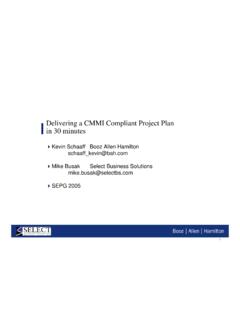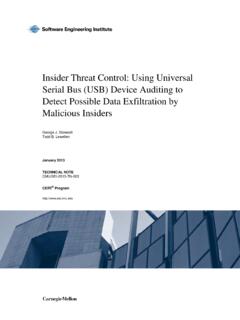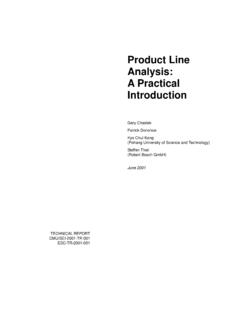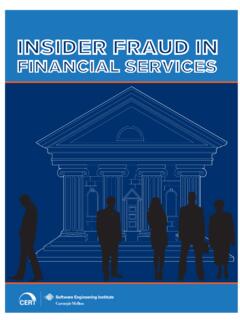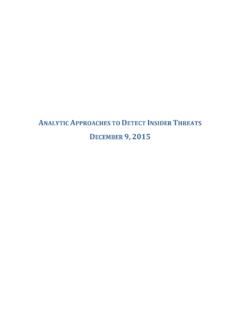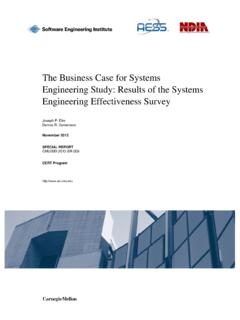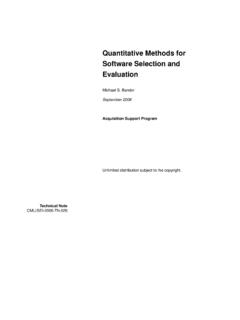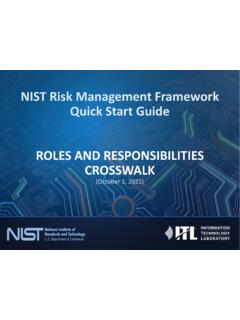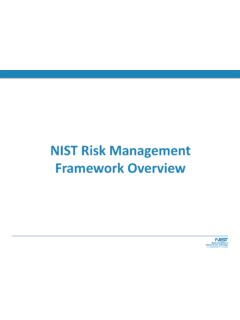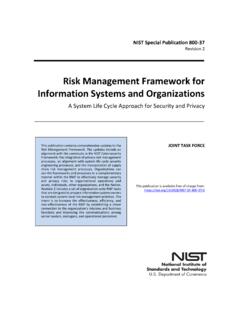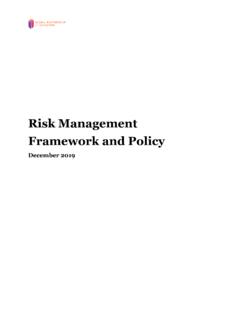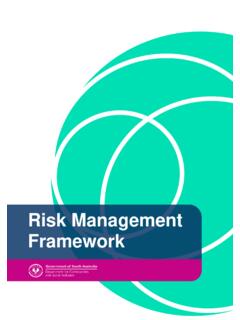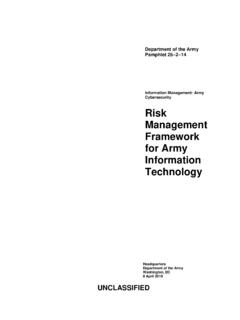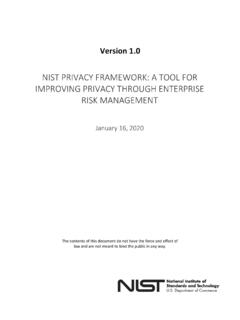Transcription of Risk Management Framework - Carnegie Mellon University
1 Risk Management Framework Christopher J. Alberts Audrey J. Dorofee August 2010. TECHNICAL REPORT. CMU/SEI-2010-TR-017. ESC-TR-2010-017. Acquisition Support Program Unlimited distribution subject to the copyright. This report was prepared for the SEI Administrative Agent ESC/XPK. 5 Eglin Street Hanscom AFB, MA 01731-2100. The ideas and findings in this report should not be construed as an official DoD position. It is published in the interest of scientific and technical information exchange. This work is sponsored by the Department of Defense. The Software Engineering Institute is a federally funded research and development center sponsored by the Department of Defense.
2 Copyright 2010 Carnegie Mellon University . NO WARRANTY. THIS Carnegie Mellon University AND SOFTWARE ENGINEERING INSTITUTE MATERIAL IS. FURNISHED ON AN AS-IS BASIS. Carnegie Mellon University MAKES NO WARRANTIES OF ANY. KIND, EITHER EXPRESSED OR IMPLIED, AS TO ANY MATTER INCLUDING, BUT NOT LIMITED TO, WARRANTY OF FITNESS FOR PURPOSE OR MERCHANTABILITY, EXCLUSIVITY, OR RESULTS OBTAINED. FROM USE OF THE MATERIAL. Carnegie Mellon University DOES NOT MAKE ANY WARRANTY OF. ANY KIND WITH RESPECT TO FREEDOM FROM PATENT, TRADEMARK, OR COPYRIGHT INFRINGEMENT. Use of any trademarks in this report is not intended in any way to infringe on the rights of the trademark holder.
3 Internal use. Permission to reproduce this document and to prepare derivative works from this document for internal use is granted, provided the copyright and No Warranty statements are included with all reproductions and derivative works. External use. This document may be reproduced in its entirety, without modification, and freely distributed in written or electronic form without requesting formal permission. Permission is required for any other external and/or commercial use. Requests for permission should be directed to the Software Engineering Institute at This work was created in the performance of Federal Government Contract Number FA8721-05-C-0003 with Carnegie Mellon University for the operation of the Software Engineering Institute, a federally funded research and development center.
4 The Government of the United States has a royalty-free government-purpose license to use, duplicate, or disclose the work, in whole or in part and in any manner, and to have or permit others to do so, for government purposes pursuant to the copyright license under the clause at For information about SEI publications, please visit the library on the SEI website ( ). Table of Contents Acknowledgments v Abstract vii 1 Introduction 1. 2 Risk Management Concepts 5. 3 Framework Overview 9. 4 Prepare for Risk Management (Phase 1) 15. 5 Perform Risk Management Activities (Phase 2) 19.
5 Assess Risk (Activity ) 24. Plan for Risk Mitigation (Activity ) 27. Mitigate Risk (Activity ) 31. 6 Sustain and Improve Risk Management (Phase 3) 35. 7 Framework Requirements 39. Appendix: Evaluating a Risk Management Practice 45. References/Bibliography 59. i | CMU/SEI-2010-TR-017. ii | CMU/SEI-2010-TR-017. List of Figures Figure 1: Components of Risk 6. Figure 2: Risk Management Activities 7. Figure 3: Framework Structure 9. Figure 4: Structure of Dataflow Diagrams 11. Figure 5: Dataflow for Phase 1 15. Figure 6: Dataflow for Phase 2 19. Figure 7: Dataflow for Activity 24.
6 Figure 8: Dataflow for Activity 27. Figure 9: Dataflow for Activity 31. Figure 10: Dataflow for Phase 3 35. iii | CMU/SEI-2010-TR-017. iv | CMU/SEI-2010-TR-017. Acknowledgments The authors would like to thank the Army Strategic Software Improvement Program (ASSIP) for pilot- ing a workshop that resulted in significant improvements to the Framework . The authors also wish to acknowledge the contributions of the reviewers, Carol Woody, Julie Cohen, and Tricia Oberndorf, and the editor of this technical report, Barbara White. v | CMU/SEI-2010-TR-017. vi | CMU/SEI-2010-TR-017.
7 Abstract Although most programs and organizations use risk Management when developing and operating soft- ware-reliant systems, preventable failures continue to occur at an alarming rate. In many instances, the root causes of these preventable failures can be traced to weaknesses in the risk Management practices employed by those programs and organizations. To help improve existing risk Management practices, Carnegie Mellon University Software Engineering Institute (SEI) researchers undertook a project to define what constitutes best practice for risk Management . The SEI has conducted research and devel- opment in the area of risk Management since the early 1990s.
8 Past SEI research has applied risk man- agement methods, tools, and techniques across the life cycle (including acquisition, development, and operations) and has examined various types of risk, including software development risk, system acqui- sition risk, operational risk, mission risk, and information security risk, among others. In this technical report, SEI researchers have codified this experience and expertise by specifying (1) a Risk Management Framework that documents accepted best practice for risk Management and (2) an approach for evaluating a program's or organization's risk Management practice in relation to the Framework .
9 Vii | CMU/SEI-2010-TR-017. viii | CMU/SEI-2010-TR-017. 1 Introduction Occurrence of Although most programs and organizations use risk Management when Preventable Failures developing and operating software-reliant systems, preventable failures continue to occur at an alarming rate. Several reasons contribute to the oc- currence of these failures, including significant gaps in the risk Management practices employed by programs and organizations uneven and inconsistent application of risk Management practices within and across organizations ineffective integration of risk Management with program and organiza- tional Management increasingly complex Management environment To help improve existing risk Management practices, Carnegie Mellon Software Engineering Institute (SEI)
10 Researchers undertook a project to define what constitutes best practice for risk Management . This technical report provides the results of that research project by specifying the follow- ing: a Risk Management Framework that documents accepted best practice for risk Management an approach for evaluating a program's or organization's risk manage- ment practice in relation to the requirements specified in the Framework SEI Background in Since the early 1990s, the SEI has conducted research and development in Risk Management the area of risk Management and has applied risk Management methods, tools, and techniques across the life cycle (including acquisition, develop- ment, and operations).

